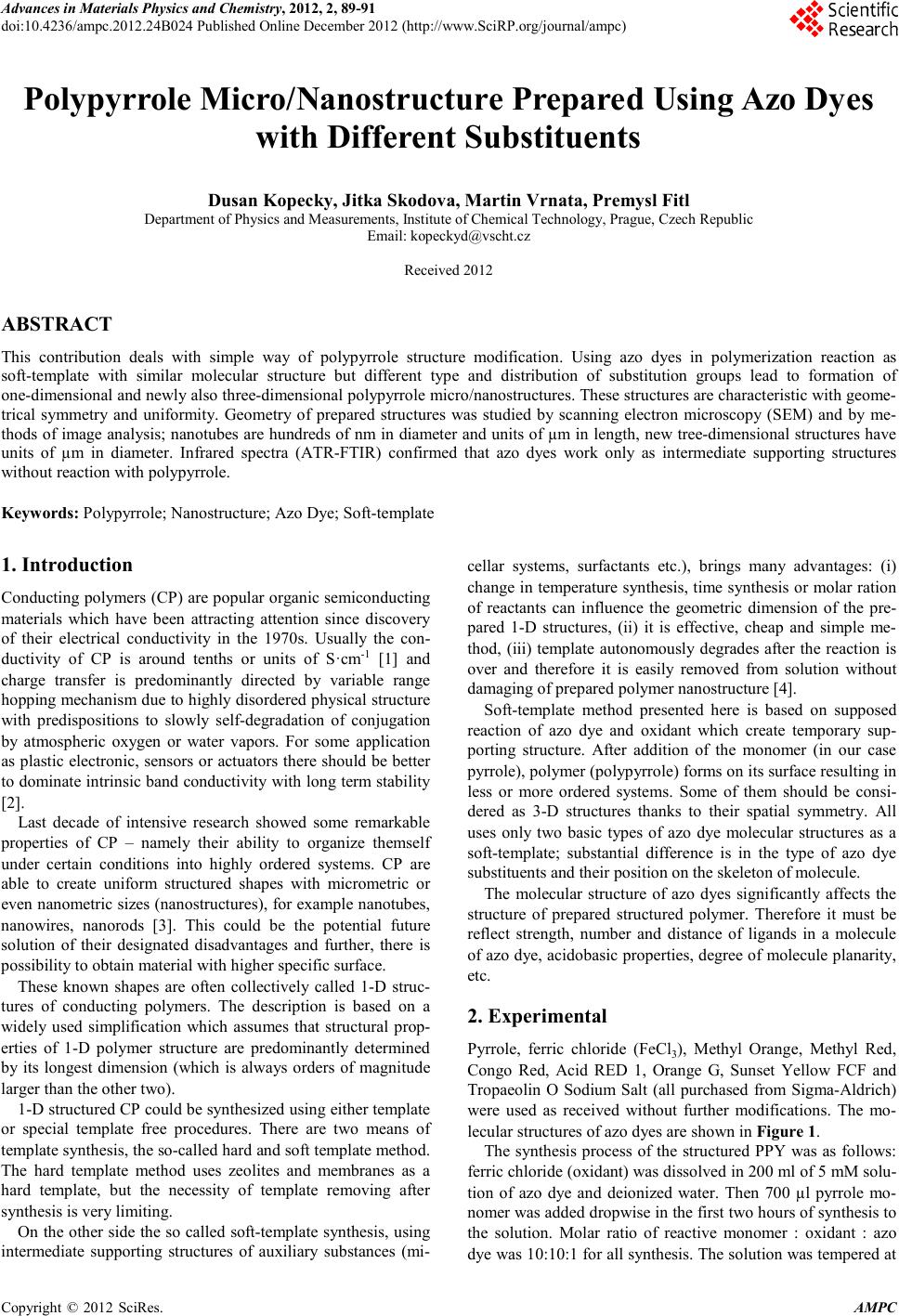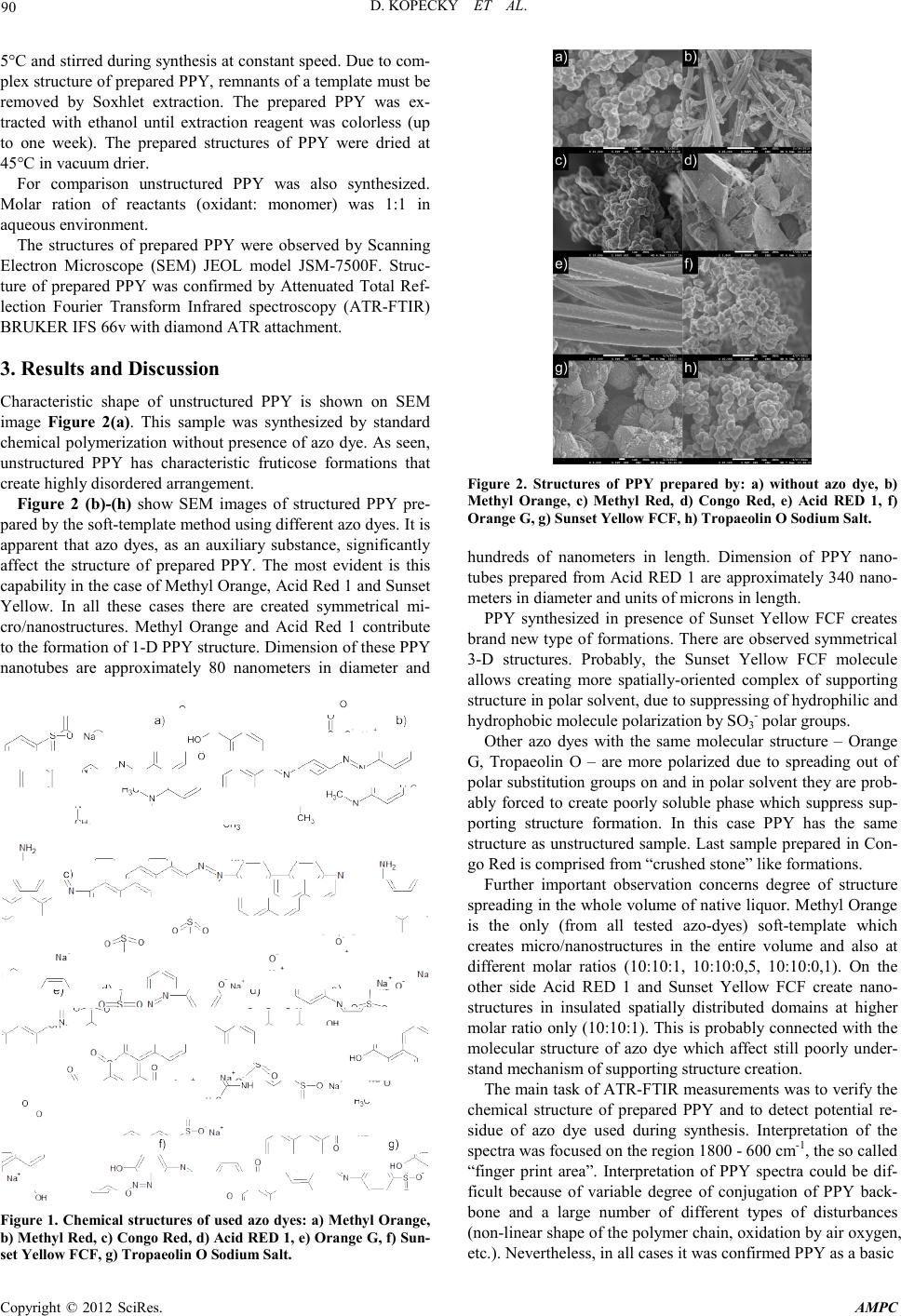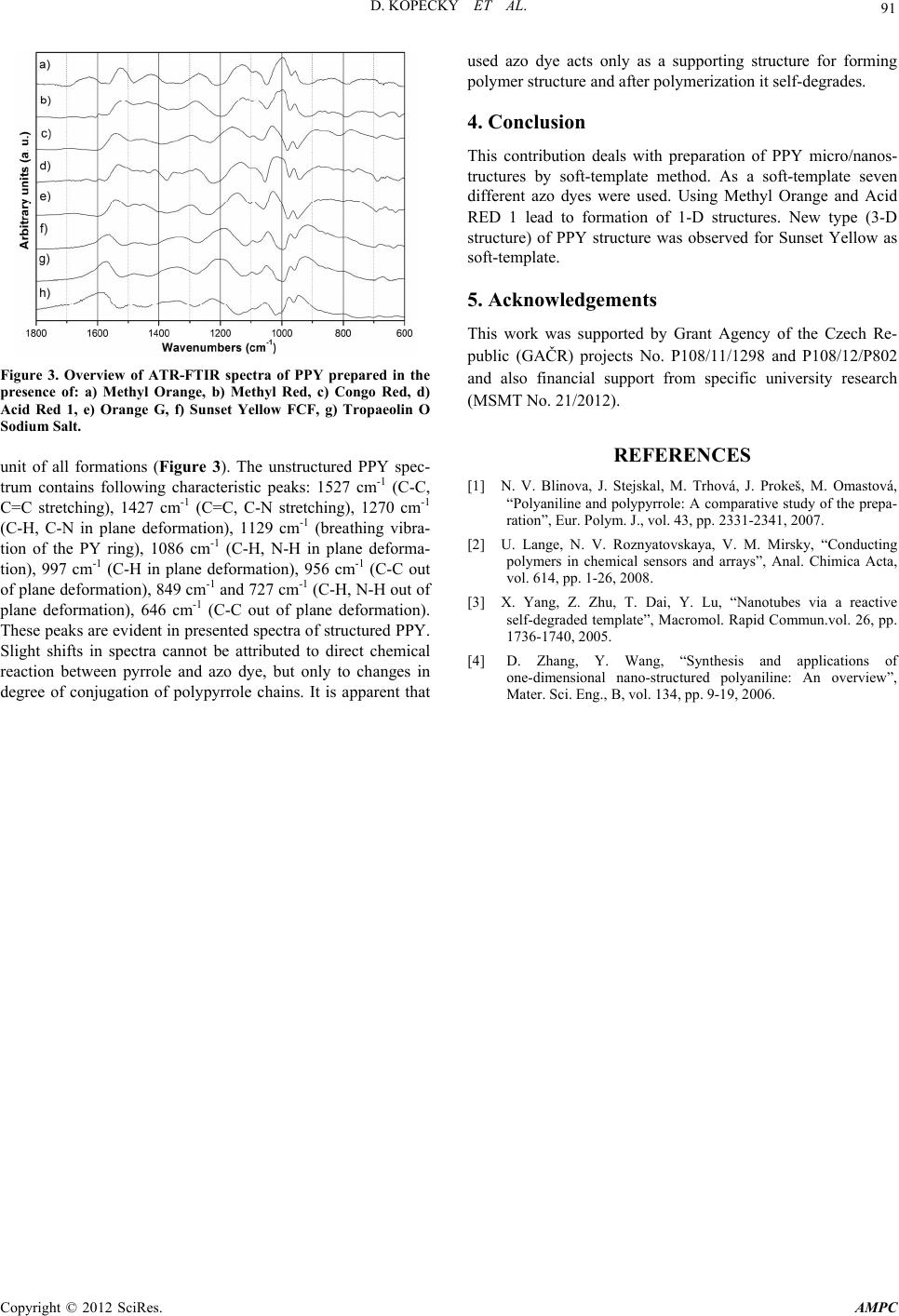Paper Menu >>
Journal Menu >>
 Advances in Ma terials Physics and Che mist ry, 2012, 2, 89-91 doi:10.4236/ampc.2012.24B024 Published Online December 2012 (htt p://www.SciRP.org/journal/ampc) Copyright © 2012 SciRes. AMPC Polypyrrole Micro/Nanostructure Prepared Using Azo Dyes wit h D i f fe rent Substit uents Dusan Kopecky, Jitka Skodova, Martin Vrnata, Premysl Fitl Department of Physics an d Mea sur ements, Institute of Chemical Technology, Prague, Czech Repub l ic Email: kopeckyd@vscht.cz Received 2012 ABSTRACT This contribution deals with simple way of polypyrrole structure modification. Using azo dyes in polymerization reaction as soft-template with similar molecular structure but different type and distribution of substitution groups lead to formation of one-dimensional and newly also three-dimension al p ol ypyrrole micro /n anost ru ctures. These str uct ur es are ch aract eri stic with geome- trical symmetry and uniformity. Geometry of prepared structures was studied by scanning electron microscopy (SEM) and by me- thods of image analysis; nanotubes are hundreds of nm in diameter and units of µm in length, new tree-dimensional structures have units of µm in diameter. Infrared spectra (ATR-FTIR) confirmed that azo dyes work only as intermediate supporting structures without reaction with polypyrrole. Keywords: Polypyrrole; Nanostructure; Azo Dye; Soft-template 1. Introduction Conducting polymers (CP) are popular organic semiconducting materials which have been attracting attention since discovery of their electrical conductivity in the 1970s. Usually the con- ductivity of CP is around tenths or units of S·cm-1 [1] and charge transfer is predominantly directed by variable range hopping mechanism due to highly disordered physical structure with predispositions to slowly self-degradation of conjugation by atmospheric oxygen or water vapors. For some application as plasti c electronic, sensors or actuato rs there should be better to dominate intrinsic band conductivity with long term stability [2] . Last decade of intensive research showed some remarkable properties of CP – namely their ability to organize themself under certain conditions into highly ordered systems. CP are able to create uniform structured shapes with micrometric or even nan ometric sizes (nanostructures), for example nanotubes, nanowires, nanorods [3] . This could be the potential future solution of their designated disadvantages and further, there is possibility to obtain material with higher specific surface. These known shapes are often collectively called 1-D struc- tures of conducting polymers. The description is based on a widely used simplification which assumes that structural prop- erties of 1-D polymer structure are predominantly determined by its longest dimension (which is always orders of magnitude larger than the other two). 1-D structured CP could be synthesized using either template or special template free procedures. There are two means of template synthesis, the so-called hard and soft template method. The hard template method uses zeolites and membranes as a hard template, but the necessity of template removing after synthesis is very limiting. On the other side the so called soft-template synthesis, using intermediate supporting structures of auxiliary substances (mi- cellar systems, surfactants etc.), brings many advantages: (i) change in temperature synthesis, time synthesis or molar ration of reactants can influence the geometric dimension of the pre- pared 1-D structures, (ii) it is effective, cheap and simple me- thod, (iii) template autonomously degrades after the reaction is over and therefore it is easily removed from solution without damaging of prepared polymer nanostructure [4]. Soft-template method presented here is based on supposed reaction of azo dye and oxidant which create temporary sup- porting structure. After addition of the monomer (in our case pyrrole), polymer (polypyrrole) forms on its surface resulting in less or more ordered systems. Some of them should be consi- dered as 3-D structures thanks to their spatial symmetry. All uses only two basic types of azo dye molecular structures as a soft-template; substantial difference is in the type of azo dye substituents and their position on the skeleton of molecule. The molecular structure of azo dyes significantly affects the structure of prepared structured polymer. Therefore it must be reflect strength, number and distance of ligands in a molecule of azo dye, acid obasic p roperties, degree o f molecule pl anarity, etc. 2. Experimental Pyrrole, ferric chloride (FeCl3), Methyl Orange, Methyl Red, Congo Red, Acid RED 1, Orange G, Sunset Yellow FCF and Tropaeolin O Sodium Salt (all purchased from Sigma-Aldrich) were used as received without further modifications. The mo- lecular s tructures of azo dyes are shown in Figure 1. The s ynthesis process of the structured PPY was as follows: ferric chloride (oxidant) was dissolved in 200 ml of 5 mM solu- tion of azo dye and deionized water. Then 700 µl pyrrole mo- nomer was added dropwise in the first two hours of synthesis to the solution. Molar ratio of reactive monomer : oxidant : azo dye was 10:10:1 for all synthesis. The solution was tempered at  D. KOPECKY ET AL. Copyright © 2012 SciRes. AMPC 90 5°C and stirred during synthesis at constant speed. Due to com- plex structure of prepared PPY, remnants of a template must be removed by Soxhlet extraction. The prepared PPY was ex- tracted with ethanol until extraction reagent was colorless (up to one week). The prepared structures of PPY were dried at 45°C in vacuum drier. For comparison unstructured PPY was also synthesized. Molar ration of reactants (oxidant: monomer) was 1:1 in aqueous environment. The structures of prepared PPY were observed by Scanning Electron Microscope (SEM) JEOL model JSM-7500F. Struc- ture of prepared PPY was confirmed by Attenuated Total Ref- lection Fourier Transform Infrared spectroscopy (ATR-FTIR) BRUKER IFS 66v with diamond ATR attachment. 3. Results and Discussion Characteristic shape of unstructured PPY is shown on SEM image Figure 2(a). This sample was synthesized by standard chemical p olymerization with out presence of azo dye. As seen, unstructured PPY has characteristic fruticose formations that create highly disor dered arr angement. Figure 2 (b)-(h) show SEM images of structured PPY pre- pared by the soft-template method using different azo dyes. It is apparent that azo dyes, as an auxiliary substance, significantly affect the structure of prepared PPY. The most evident is this capabi lit y in th e case of Met h yl Oran ge, Acid Red 1 and Sun set Yellow. In all these cases there are created symmetrical mi- cro/nanostructures. Methyl Orange and Acid Red 1 contribute to the formation of 1-D PPY structure. Di mension o f these PPY nanotubes are approximately 80 nanometers in diameter and Figure 1. Chemical structures of used azo dyes: a) Methyl Orange, b) Methyl Red, c) Congo Red, d) Acid RED 1, e) Orange G, f) Sun- set Yellow FCF, g) Tropaeolin O Sodium Salt. Figure 2. Structures of PPY prepared by: a) without azo dye, b) Methyl Orange, c) Methyl Red, d) Congo Red, e) Acid RED 1, f) Orange G, g) Sunset Yellow FCF, h) Tropaeoli n O Sodium Salt. hundreds of nanometers in length. Dimension of PPY nano- tubes prepared from Acid RED 1 are approximately 340 nano- meters in diameter and units of microns in length. PPY synthesized in presence of Sunset Yellow FCF creates brand new type of formations. There are o bserved symmet rical 3-D structures. Probably, the Sunset Yellow FCF molecule allows creating more spatially-oriented complex of supporting structure in polar solvent, due to suppressing of hydrophilic and hydrophobic molecule polarization by SO3- polar groups. Other azo dyes with the same molecular structure – Orange G, Tropaeolin O – are more polarized due to spreading out of polar substitution groups on and in polar solvent they are prob- ably forced to create poorly soluble phase which suppress sup- porting structure formation. In this case PPY has the same structure as unst ructured sample. Last sa mple p repared in C on- go Red is comprised from “crushed stone” like formations. Further important observation concerns degree of structure spreading in the whole volume of native liquor. Methyl Orange is the only (from all tested azo-dyes) soft-template which creates micro/nanostructures in the entire volume and also at different molar ratios (10:10:1, 10:10:0,5, 10:10:0,1). On the other side Acid RED 1 and Sunset Yellow FCF create nano- structures in insulated spatially distributed domains at higher molar ratio only (10:10:1). This is probably connected with the molecular structure of azo dye which affect still poorly under- stand mechanism of supporting structure creation. The main tas k of ATR-F TIR measu rement s was to veri fy the chemical structure of prepared PPY and to detect potential re- sidue of azo dye used during synthesis. Interpretation of the spectra was focused on the region 1800 - 600 cm-1, the so called “finger print area”. Interpretation of PPY spectra could be dif- ficult because of variable degree of conjugation of PPY back- bone and a large number of different types of disturbances (non-linear shape of the polymer chain, oxidation by air oxygen, etc.). Nevertheless, in all cases it was confirmed PP Y as a basic  D. KOPECKY ET AL. Copyright © 2012 SciRes. AMPC 91 Figure 3. Overview of ATR-FTIR spectra of PPY prepared in the presence of: a) Methyl Orange, b) Methyl Red, c) Congo Red, d) Acid Red 1, e) Orange G, f) Sunset Yellow FCF, g) Tropaeolin O Sodium Salt. unit of all formations (Figure 3). The unstructured PPY spec- trum contains following characteristic peaks: 1527 cm-1 (C-C, C=C stretching), 1427 cm-1 (C=C, C-N stretching), 1270 cm-1 (C-H, C-N in plane deformation), 1129 cm-1 (breathing vibra- tion of the PY ring), 1086 cm-1 (C-H, N-H in plane deforma- tion), 997 cm-1 (C-H in plane deformation), 956 cm-1 (C-C out of plane deformation), 849 cm-1 and 727 cm-1 (C-H, N-H out of plane deformation), 646 cm-1 (C-C out of plane deformation). These peaks are evident in presented spectra of structured PPY. Slight shifts in spectra cannot be attributed to direct chemical reaction between pyrrole and azo dye, but only to changes in degree of conjugation of polypyrrole chains. It is apparent that used azo dye acts only as a supporting structure for forming polymer structure and after polymerization it self-degrades. 4. Conclusion This contribution deals with preparation of PPY micro/nanos- tructures by soft-template method. As a soft-template seven different azo dyes were used. Using Methyl Orange and Acid RED 1 lead to formation of 1-D structures. New type (3-D structure) of PPY structure was observed for Sunset Yellow as soft-template. 5. Acknowledgements This work was supported by Grant Agency of the Czech Re- public (GAČR) projects No. P108/11/1298 and P108/12/P802 and also financial support from specific university research (MSMT No. 21/2012). REFERENCES [1] N. V. Blinova, J. Stejskal, M. Trhová, J. Prokeš, M. Omastová, “Polyaniline and polypyrrole: A comparative study of the prepa- ration”, Eur. Polym. J., vol. 43, pp. 2331-2341, 2007. [2] U. Lange, N. V. Roznyatovskaya, V. M. Mirsky, “Conducting polymers in chemical sensors and arrays”, Anal. Chimica Acta, vol. 614, pp. 1-26, 2008. [3] X. Yang, Z. Zhu, T. Dai, Y. Lu, “Nanotubes via a reactive self-degraded template”, Macromol. Rapid Commun.vol. 26, pp. 1736-1740, 2005. [4] D. Zhang, Y. Wang, “Synthesis and applications of one-dimensional nano-structured polyaniline: An overview”, Mater. Sci. Eng., B, vol. 134, pp. 9-19, 2006. |

